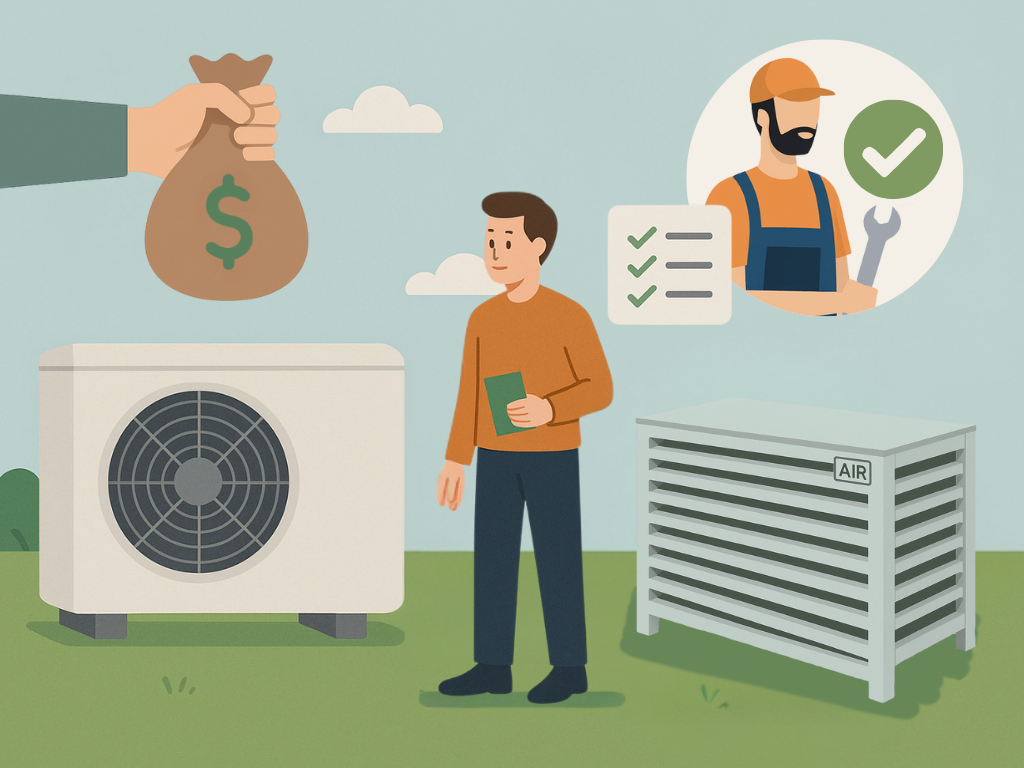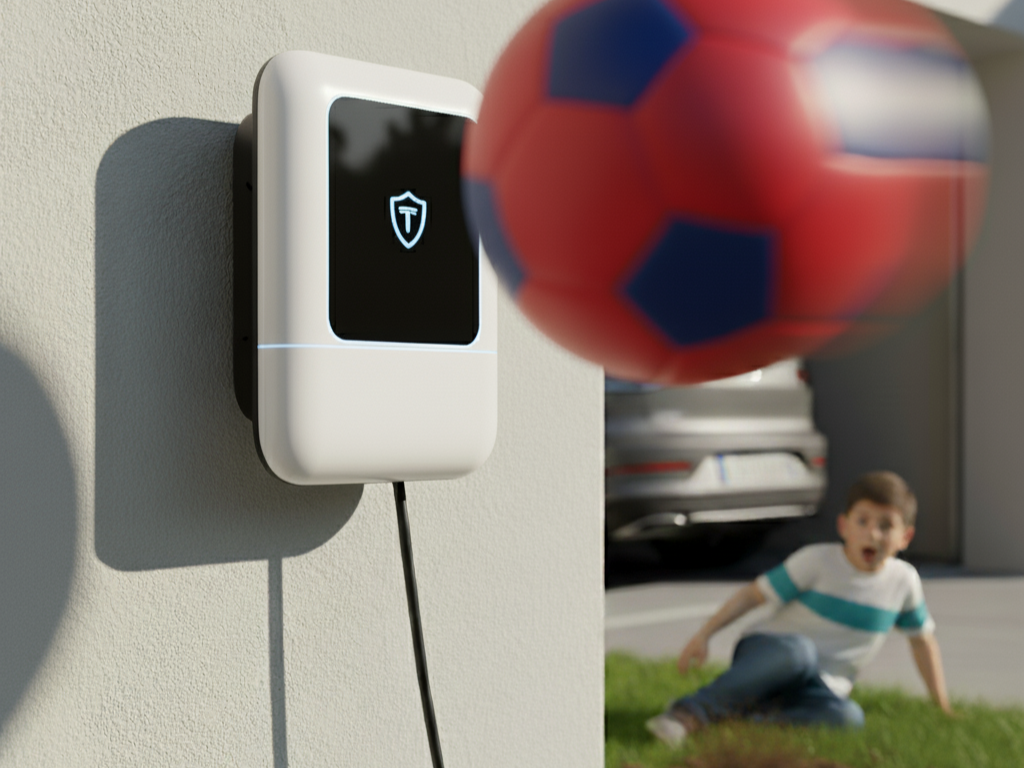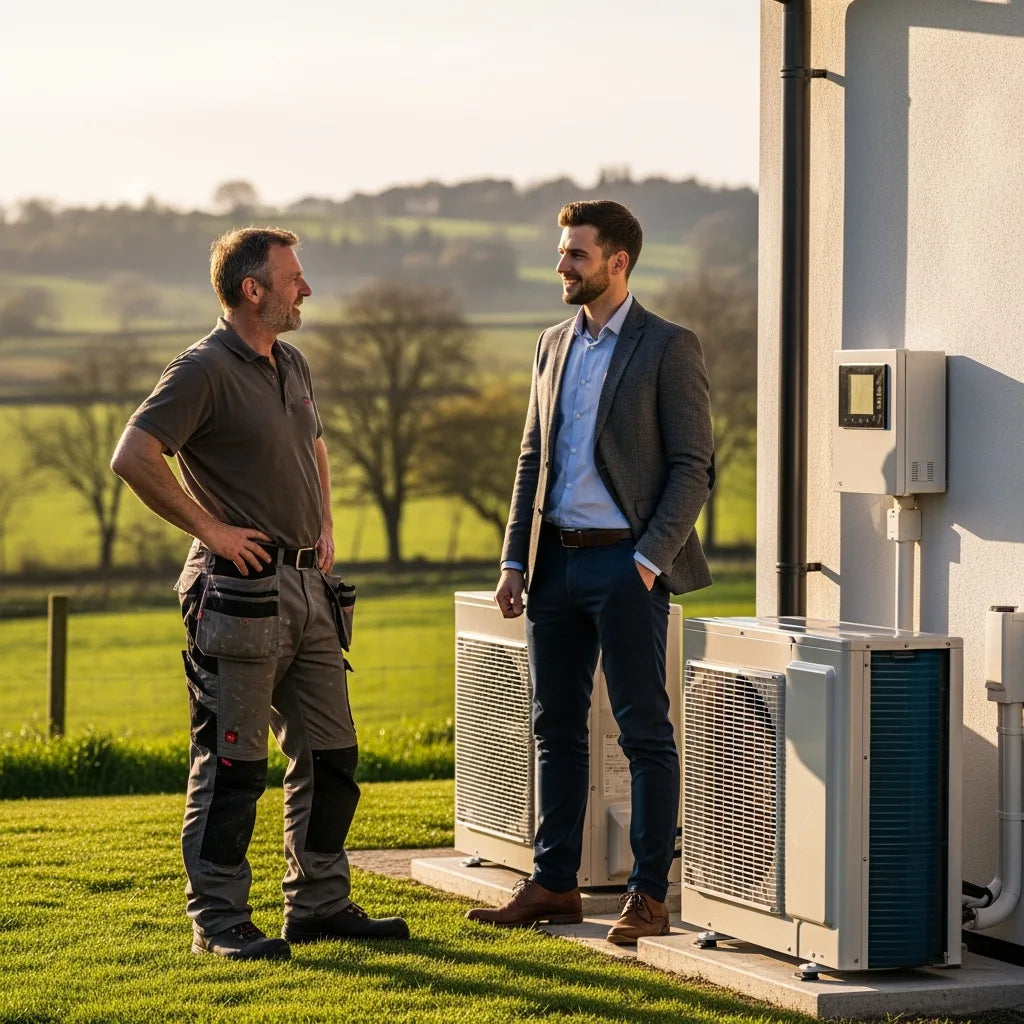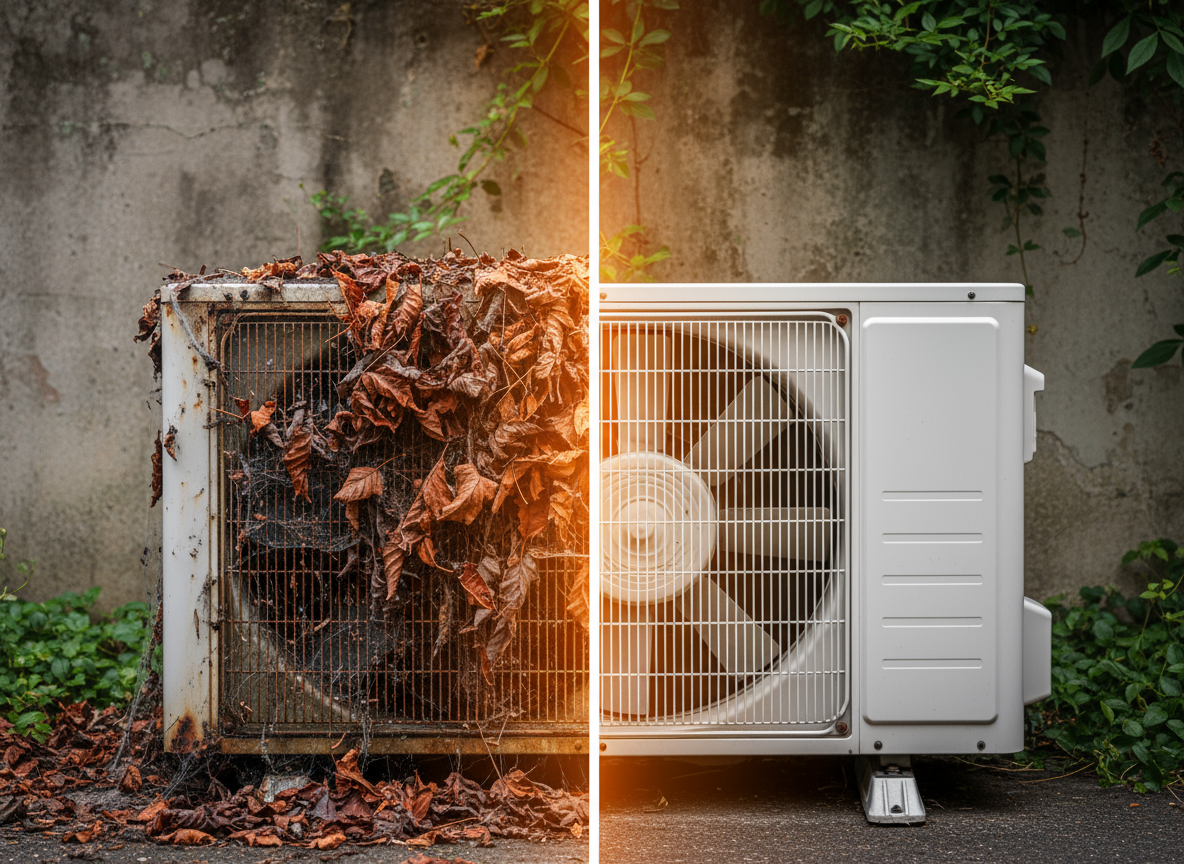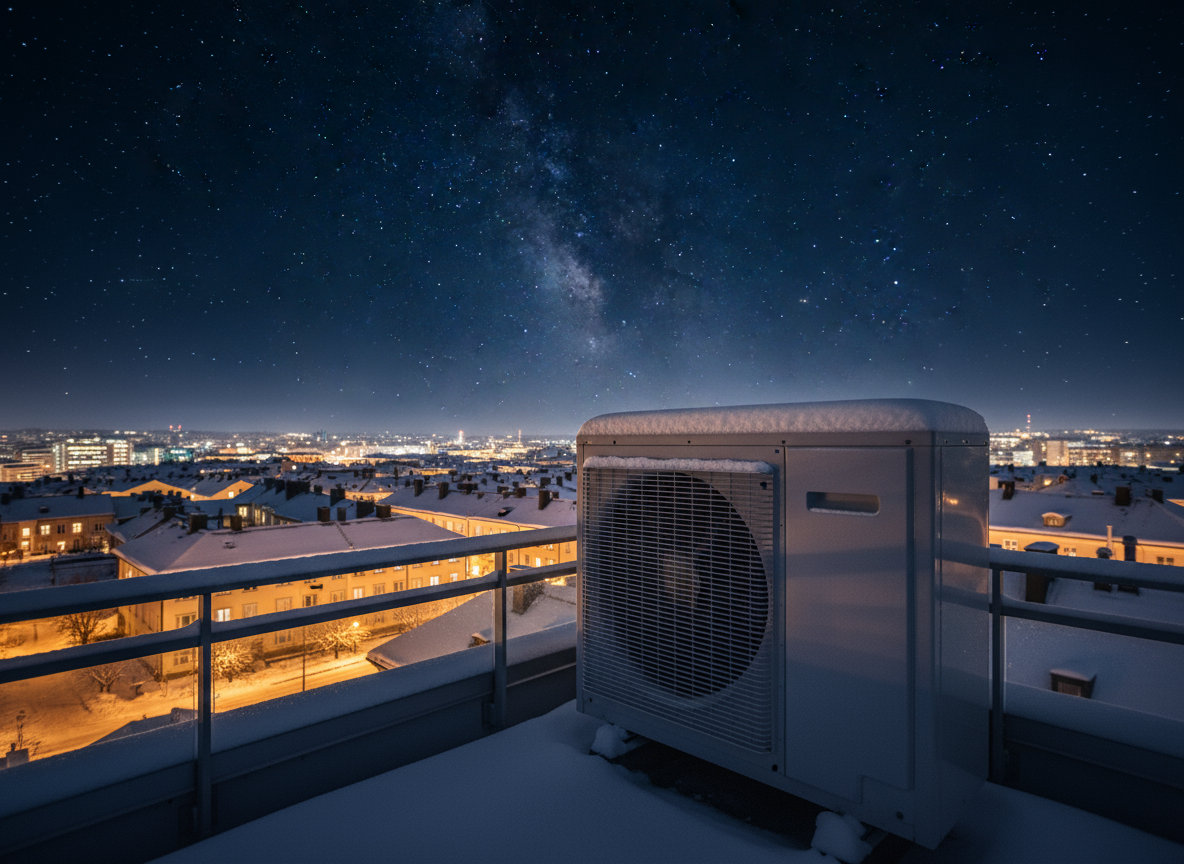The role of air conditioners in guest comfort
In an accommodation facility, air conditioners are not just technical devices: they are a fundamental part of the guest experience. Comfortable rooms, well-air-conditioned common areas, and workspaces with controlled temperature directly affect satisfaction and reviews. Protecting air conditioners therefore means ensuring service continuity and preserving a strategic asset of the hotel.

End of season: what happens to outdoor units
Humidity, rain and frost: the silent enemies
When summer ends, hotels often leave outdoor air conditioners exposed to high humidity, heavy rainfall and, at night or during cold snaps, sub-zero temperatures. Combined, these factors create the perfect environment for corrosion, rust and invisible internal damage. Even small cracks or joints can become entry points for water, which accelerates the deterioration of metal components.

According to HVAC industry studies, frequent contact with water (rain, snow, ice) and prolonged humidity can cause phenomena such as galvanic corrosion, where different metals in contact oxidize prematurely.
Smog, dust and salt air: issues for city and seaside hotels
In urban contexts, smog and airborne particles carry oxides, fine dust and aggressive substances that settle on outdoor unit components: grilles, heat exchangers, and shrouds (CRE Insight Journal). This build-up:
- reduces airflow,
- impairs heat exchange, and
- forces the AC to work harder, increasing energy use.

In coastal locations, salt air—rich in chlorides—is particularly harmful (Lessen). As reported in technical sources, the build-up of salt and moisture accelerates corrosion of aluminum and copper components and can cause
- micro-leaks,
- oxidation, and
- electrical malfunctions.
Aesthetic degradation: yellowing and rusting units
Beyond functionality, the visual appearance of outdoor AC units greatly influences how guests perceive the hotel. In the following ways:
- Discoloration of plastics and coatings due to exposure to the elements (rain, residual sun, wind laden with particles).
- Rust stains appearing at contact points, on grilles or around bolts: a concrete sign of ongoing oxidation.
- Buildup of dull films and deposits that create a neglected look, diminishing the aesthetics of façades, balconies or terraces where the units are visible.

This visual degradation is not only cosmetic: it can be an early warning of more serious damage, because where external corrosion is visible, components beneath the surface are likely compromised. Spotting these signs before they worsen can help anticipate maintenance.
For more on aesthetic and technical damage caused by salt air on HVAC, see this study on hotels in Greece analyzing salt deposits and significant corrosion on outdoor equipment.
Soft covers: a quick but temporary solution
The advantages of seasonal covers
Soft covers are one of the most common solutions chosen by hotels. They offer some immediate benefits: low cost, easy installation and decent protection from leaves, rain and dirt during autumn and winter months. They are therefore a quick option for properties with few outdoor units or for those seeking a temporary, low-investment defense.

The most common limits of soft covers for hotels
Despite their popularity, soft covers have several limitations. The most significant is the risk of internal condensation, which can cause mold, corrosion and bad odors. In addition, they deteriorate quickly, requiring frequent replacement, and become impractical for hotels with dozens or hundreds of units. Finally, their use requires time and labor for installation, removal and storage, increasing operating costs.
Why covers aren’t enough in summer
Soft covers are designed for seasonal use and offer no protection in the summer months. In fact, in summer it would be impossible to leave the units covered without compromising operation. This means they remain exposed to UV rays, extreme heat and the elements, precisely when air conditioners work the hardest. For this reason, traditional covers are an incomplete solution: they partially protect in winter but offer no protection in summer, leaving AC units vulnerable.

Long-term protection: the path to safety and savings
What a permanent protection for air conditioners is
A permanent protection for air conditioners is a fixed structure designed to cover and protect outdoor units in all seasons. Unlike soft, temporary solutions, it doesn’t need to be removed or replaced: it is installed once and provides a constant barrier against weather, UV rays and salt air. In this way, air conditioners remain safe 365 days a year, without hotel staff having to worry about seasonal operations, and reducing the need for unit maintenance.

How it protects outdoor units all year round
Quality permanent protection is designed with durable materials and with a design that allows optimal ventilation of the units, without obstructing heat exchange. This means that:
- in autumn and winter it protects from rain, frost, wind and leaf build-up,
- in spring it reduces risks related to dust and pollen,
- in summer it shields from UV rays and limits exposure to extreme temperatures, keeping the housing and components more intact over time.

Box Air Klima: an example of definitive protection for hotels
Among the available solutions, Box Air Klima is a concrete example of permanent protection designed specifically for hotels and accommodation facilities. It is a screening box that combines robustness, elegant design and technical functionality. It is designed to protect outdoor units from weather and pollution, without compromising ventilation and maintenance accessibility.
Unlike seasonal covers, Box Air Klima remains installed all year round, reducing management costs and also improving the aesthetic appearance of façades, balconies and common areas. To learn more, see the page dedicated to Box Air Klima.

The economic benefits in the medium to long term
Choosing a permanent solution like Box Air Klima doesn’t just protect air conditioners: it also optimizes operating costs. Hotels adopting such solutions gain several advantages:
- Maintenance savings: fewer emergency callouts and fewer premature replacements.
- Greater unit lifespan: proper protection can extend the service life of outdoor units by several years.
- Consistent energy efficiency: by reducing dust and build-up and exposure to humidity, UV and extreme temperatures, systems run better and consume less.
- Aesthetic enhancement: tidy façades and terraces positively impact the hotel’s image and guest perception.

Checklist for hotels: how to truly protect air conditioners
✓ Assess the number and location of units
The first step is to map all outdoor units in the property. It’s not just about quantity but also about location:
- North-facing façades: more prone to humidity and frost.
- South/west-facing façades: more exposed to sun and summer heat.
- Units on balconies and terraces: more visible to guests, and thus to be cared for aesthetically as well.
- Units on rooftops or in plant rooms: exposed to wind and driving rain.
Accurate mapping makes it possible to understand which units require greater protection and to plan investments more effectively.
✓ Consider local climate and environmental conditions
Every hotel is located in a different environmental context, and risks change accordingly:
- Cities with high smog levels: fine dust and oxides reduce efficiency over time.
- Coastal areas: salt air accelerates corrosion of copper and aluminum.
- Mountain locations: frost, snow and freeze-thaw cycles create structural stress.
- Mild but humid climates: promote condensation and mold.
✓ Choose between temporary and permanent solutions
There is no one-size-fits-all solution. Hotels must weigh pros and cons between soft covers and permanent protections:
- Soft covers: suitable for small properties with few units and limited budgets; however, they require seasonal install/remove cycles and carry risks, plus they need periodic replacement.
- Permanent protections: higher upfront investment, but they ensure continuous protection, fewer operational tasks and longer unit life.
✓ Don’t forget aesthetics and guest comfort
Beyond technical functionality, hotels must also consider visual impact and acoustic comfort. Well-protected outdoor units:
- maintain a clean, well-kept appearance on façades and balconies,
- can help reduce noise,
- improve the perceived quality and attention to detail among guests.
As highlighted by HOTREC, the European umbrella association for hotels, perceived service quality also comes from architectural and environmental details that convey care and reliability.
Frequently asked questions about protecting air conditioners in hotels
Do outdoor air conditioners really need to be covered in winter?
Yes, but not always in the same way. In locations exposed to rain, wind, frost and leaves, physical protection reduces infiltration and pooling.
- Seasonal covers: useful for few units and short periods.
- Permanent protection: ideal when there are many units or severe conditions; reduces seasonal activities and extends service life.
Whatever you choose, avoid condensation and let the outdoor unit “breathe”.
Are soft covers sufficient for a hotel?
It depends on scale and context. With dozens or hundreds of units, soft covers entail:
- install/remove/store cycles (recurring operating costs);
- condensation risk if they are not breathable;
- winter-only protection, none in summer.
For continuous needs, consider a permanent screen that withstands weather, smog and salt air and does not block airflow.
Is it possible to protect air conditioners from summer sun as well?
Yes. A well-designed fixed protection can shield from UV rays and reduce direct sun exposure, preserving housings and wiring, without hindering ventilation.
- Ventilating geometries and easy maintenance access.
- UV-resistant and corrosion-resistant materials.
- Placement that does not block discharge and intake.
This way you get 365-day protection (winter + summer) that is more consistent than soft covers alone.
How much does permanent protection cost compared to seasonal covers?
The initial investment is higher than a soft cover, but it is usually offset by:
- less extraordinary maintenance and fewer premature replacements,
- no seasonal cycles (fewer staff hours),
- greater durability of the units and a more polished image.
Assess the ROI over 3–5 years by comparing current operating costs with those estimated for a permanent solution.
Are these solutions suitable only for hotels or also for other facilities?
Not just hotels. The same principles apply to residences, student housing, care homes, retail, offices and diffuse hospitality. Where there are many or exposed outdoor units, structural protection improves service continuity, image and costs.
In the hotel context, a permanent solution reconciles protection, accessibility and aesthetics.
Conclusions: the hotel guide to protecting air conditioners
Protecting outdoor air conditioner units is not a technical detail to overlook: it is a strategic choice for any hotel that wants to ensure service continuity, energy efficiency and a well-kept image in the eyes of guests. The end of the summer season is the ideal time to assess risks, analyze local environmental conditions and decide how to preserve your investment.
Soft covers offer temporary, immediate protection, but show clear limitations in the medium to long term, especially for properties with numerous outdoor units. By contrast, permanent solutions protect air conditioners 365 days a year, reducing extraordinary maintenance costs while improving the hotel’s aesthetic appeal.
A concrete example is Box Air Klima, which combines technical protection, durability and architectural design. Investing in permanent protection means ensuring maximum guest comfort, preserving the equipment and strengthening the property’s reputation.
Ultimately, every hotel should ask itself: how valuable is the peace of mind of knowing that its air conditioners are always safe? The answer lies not only in the numbers, but in the quality of service perceived by guests—what truly makes the difference in a competitive market.



